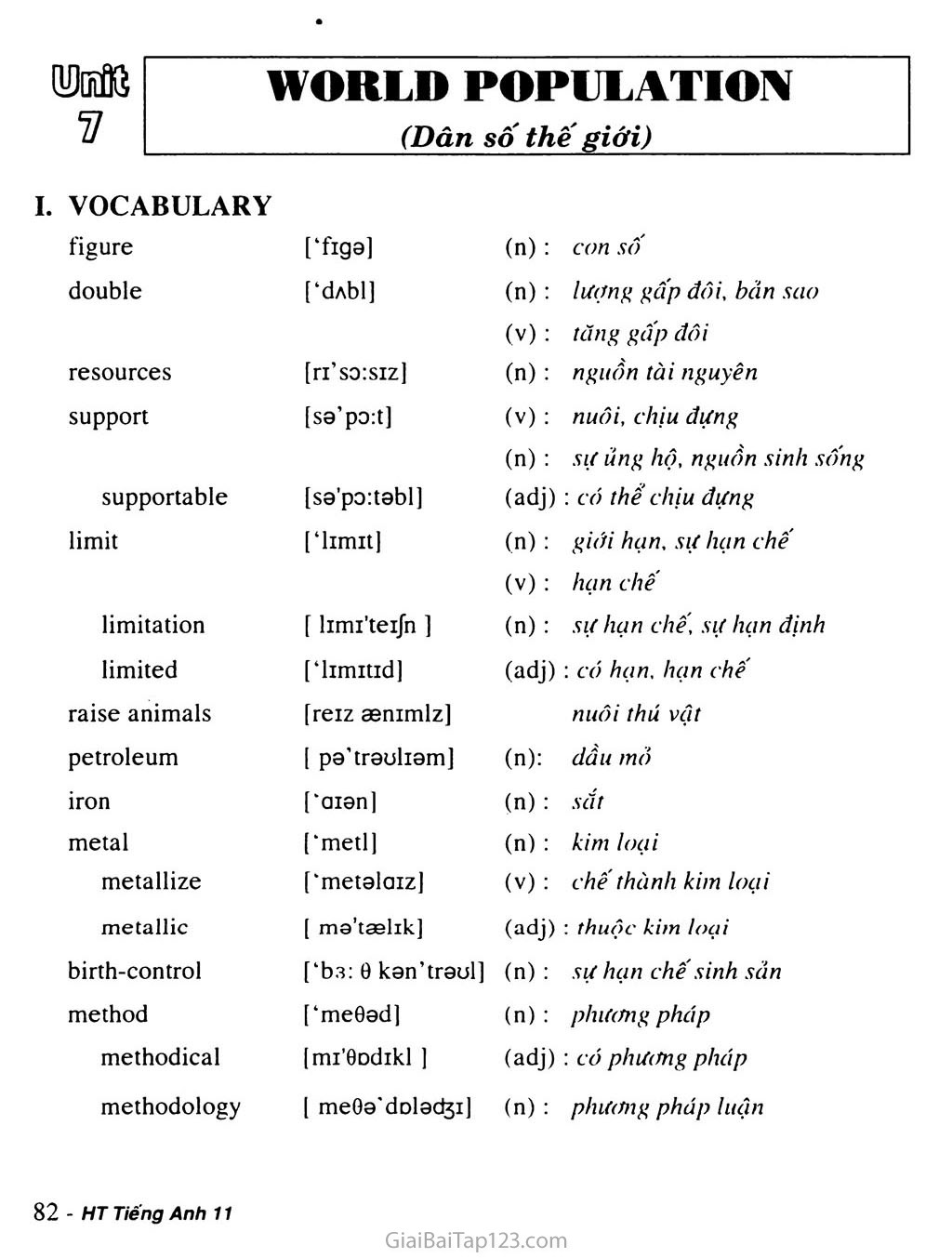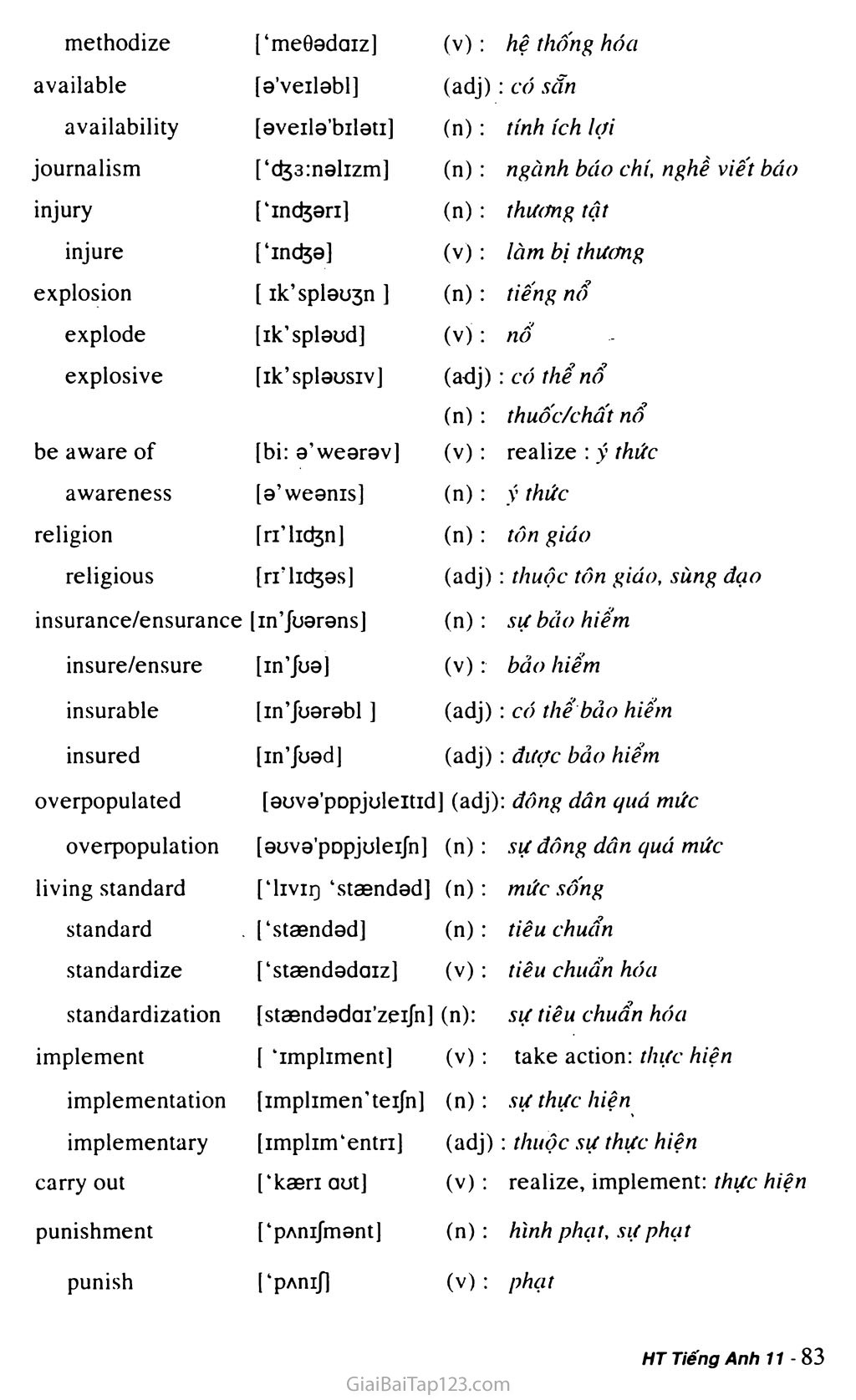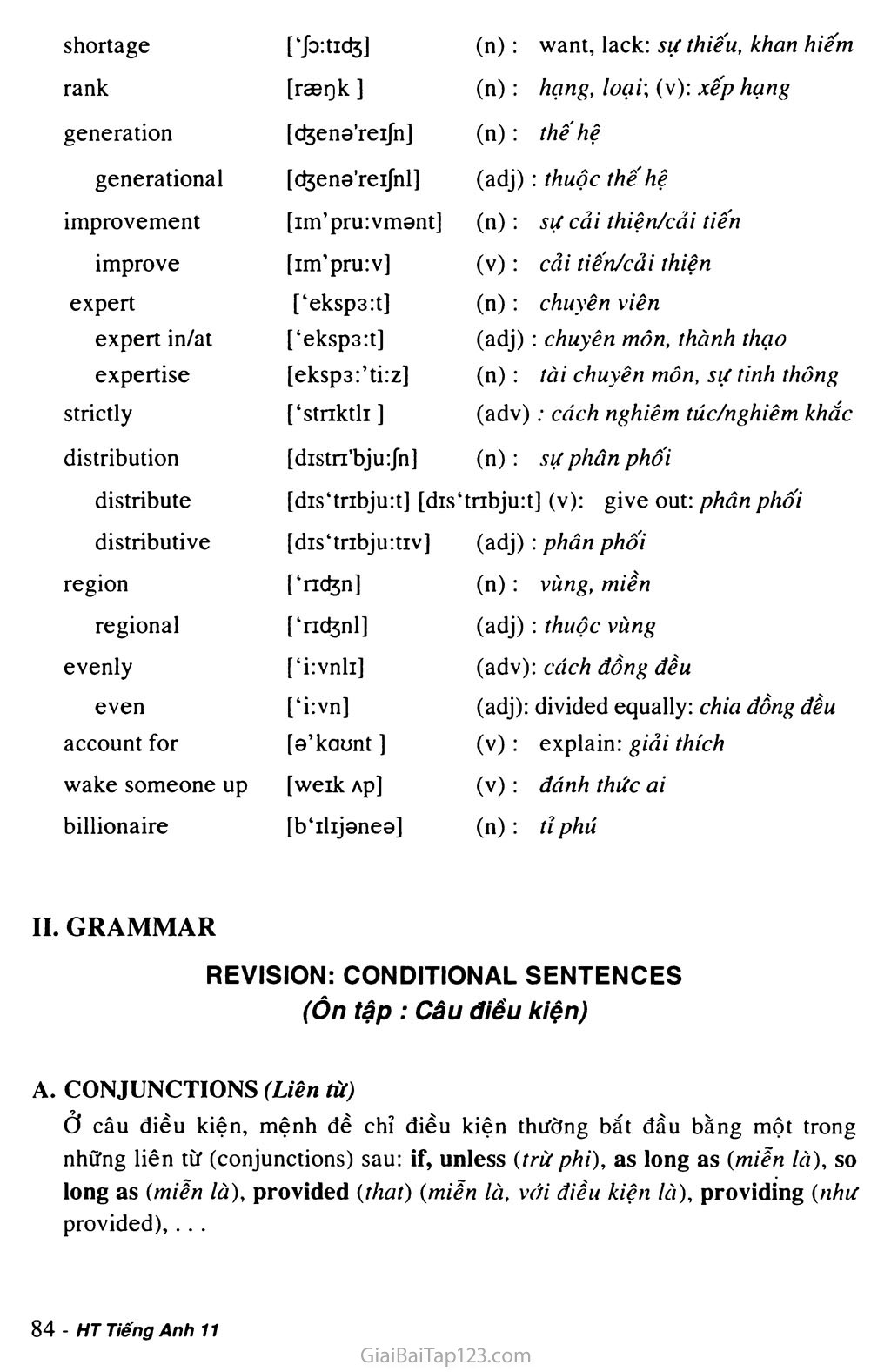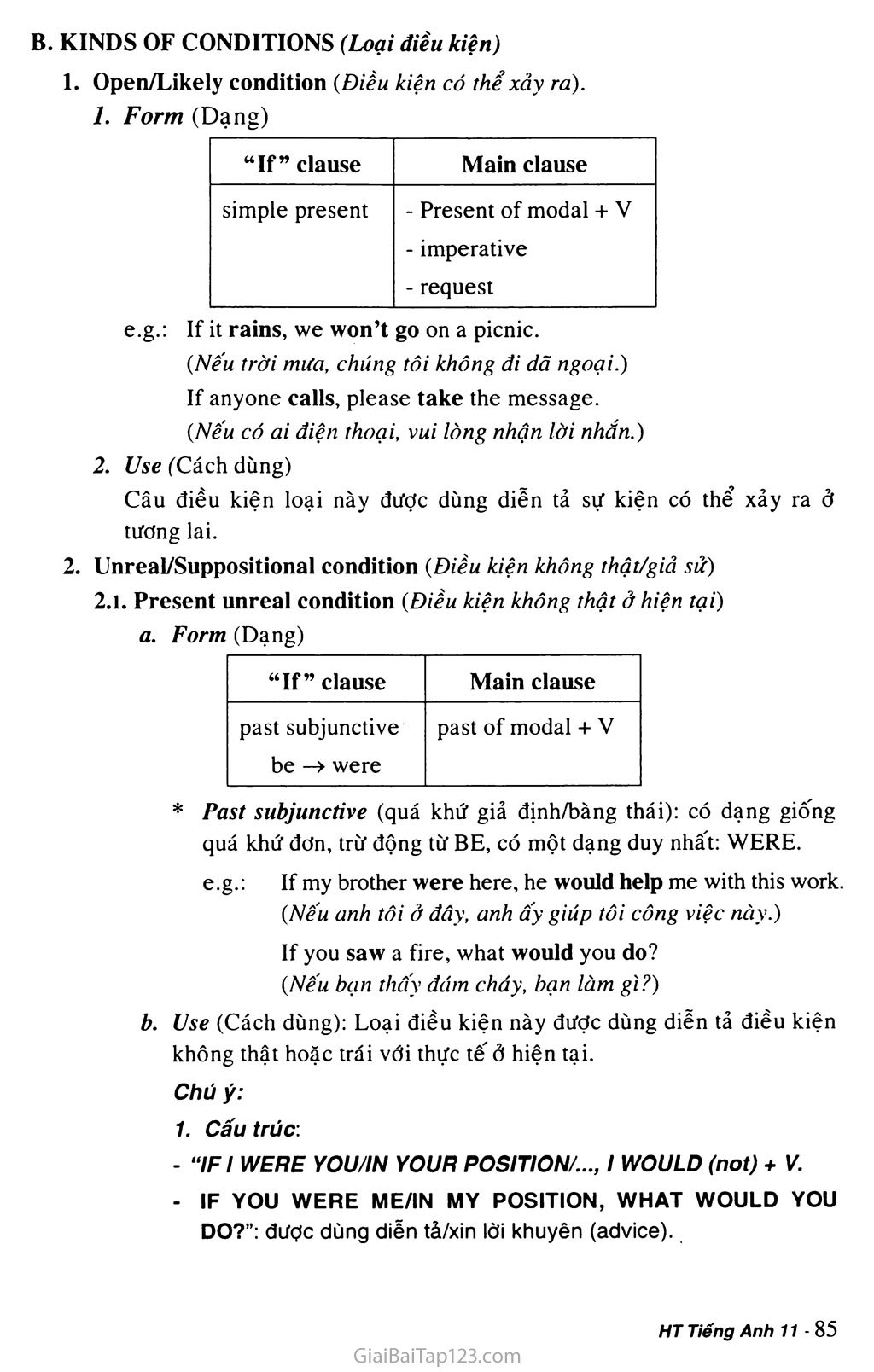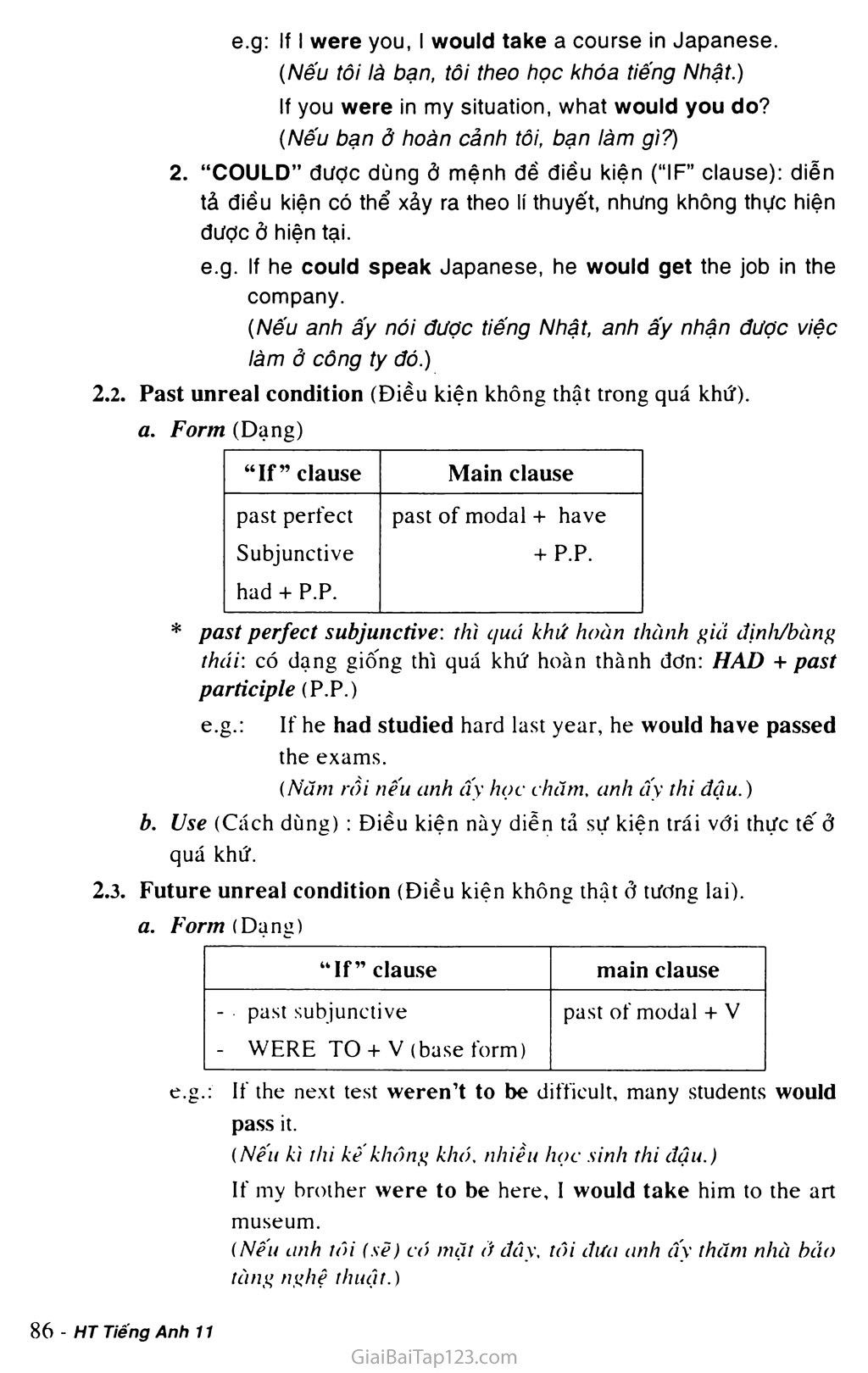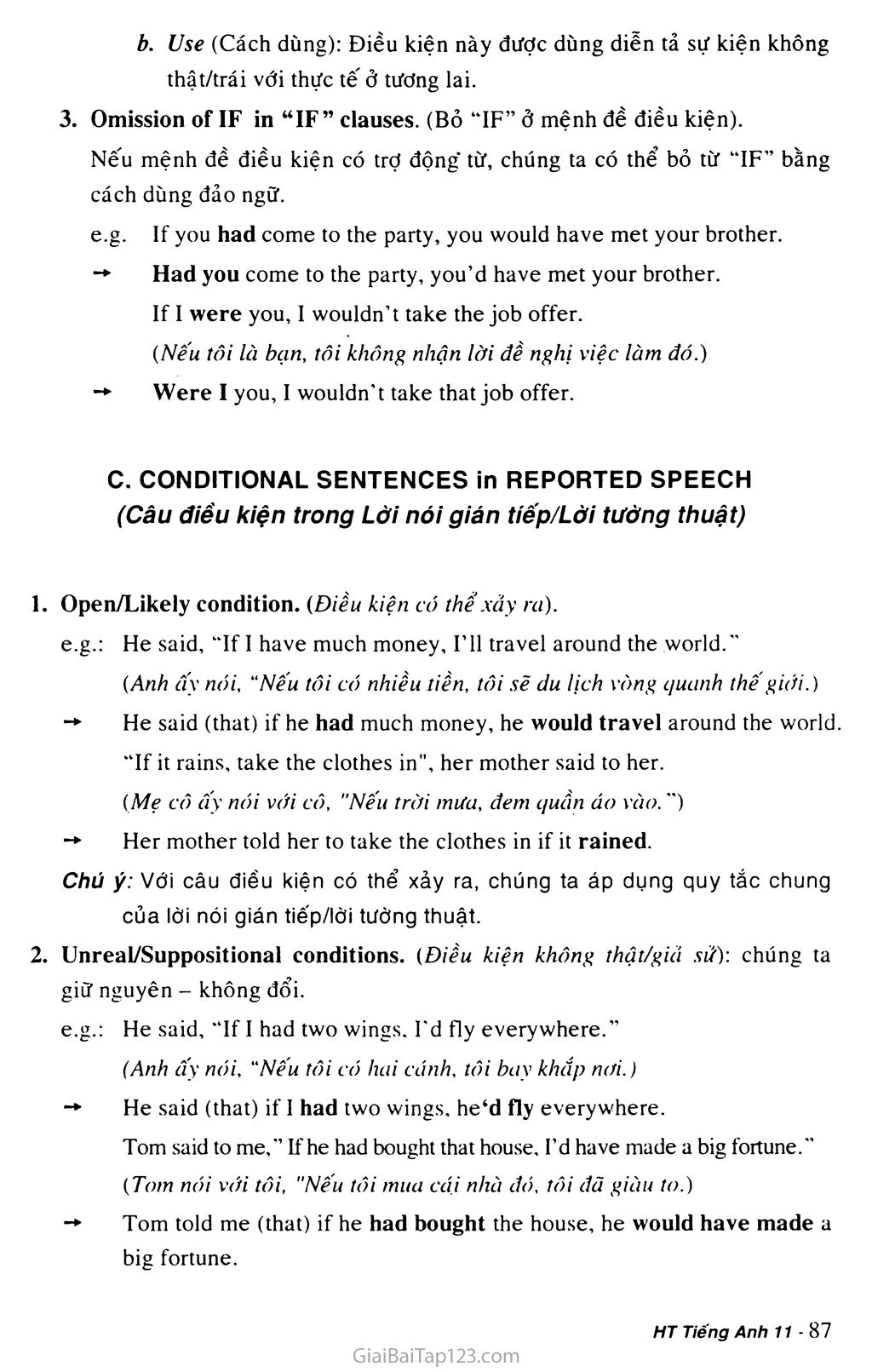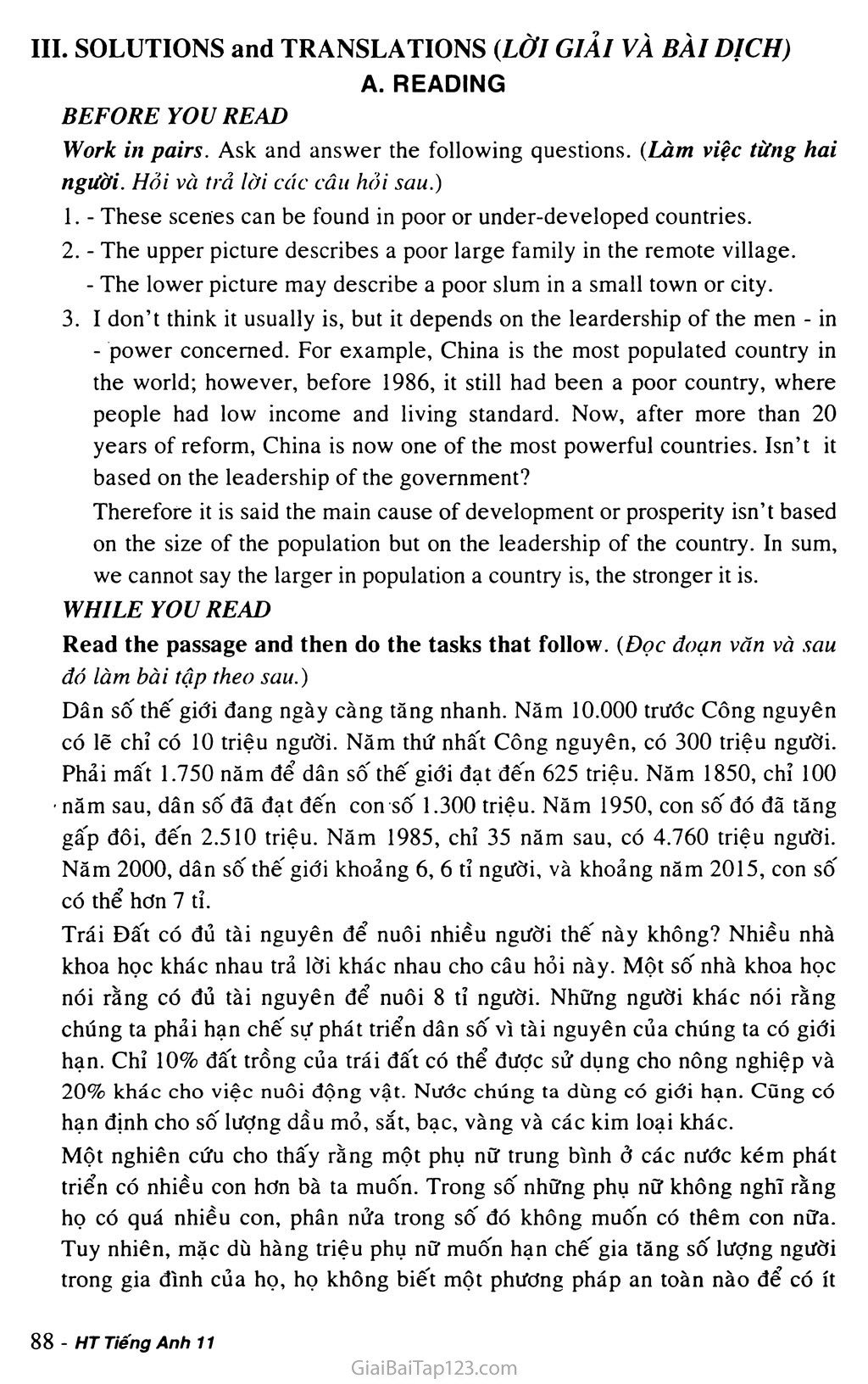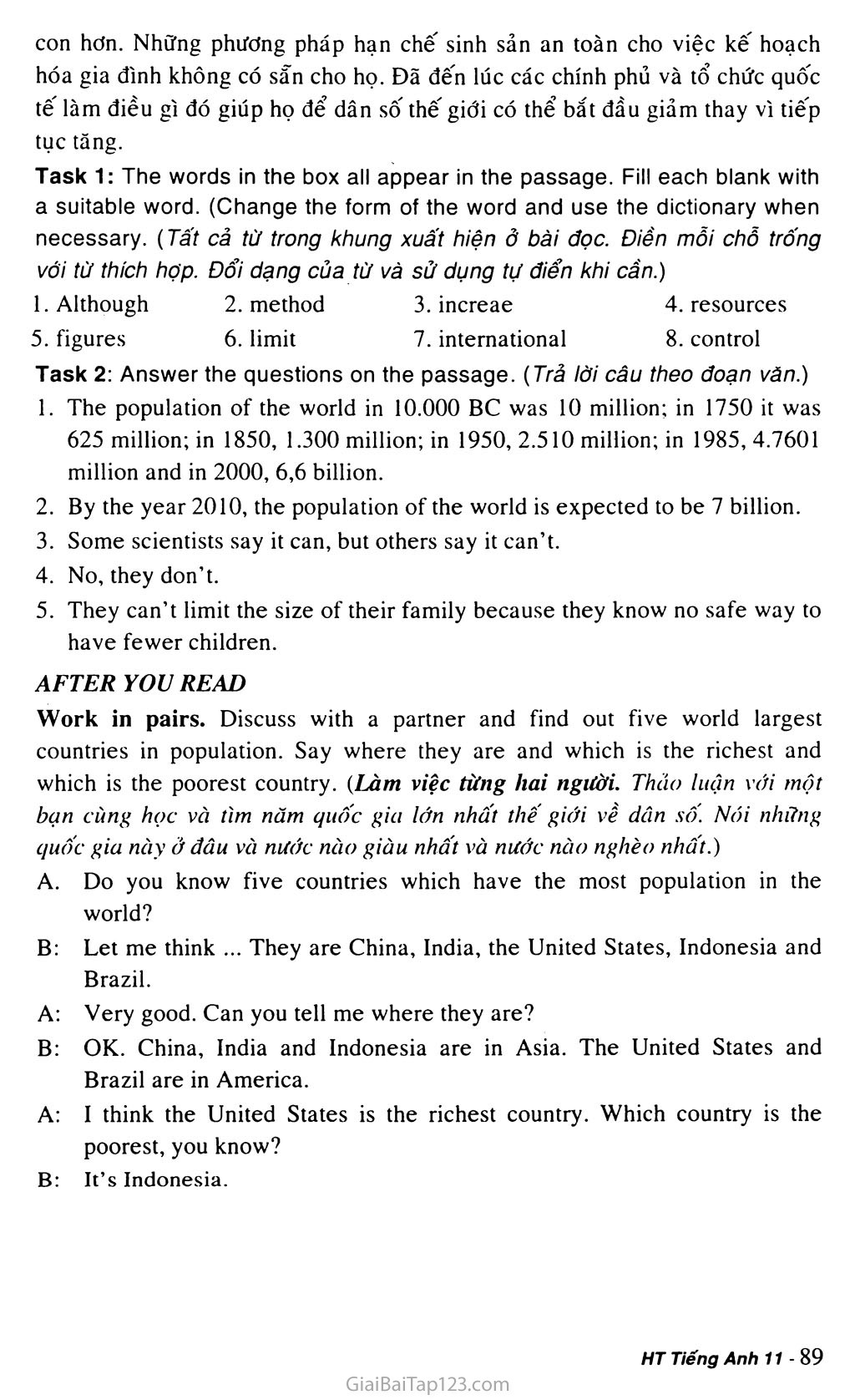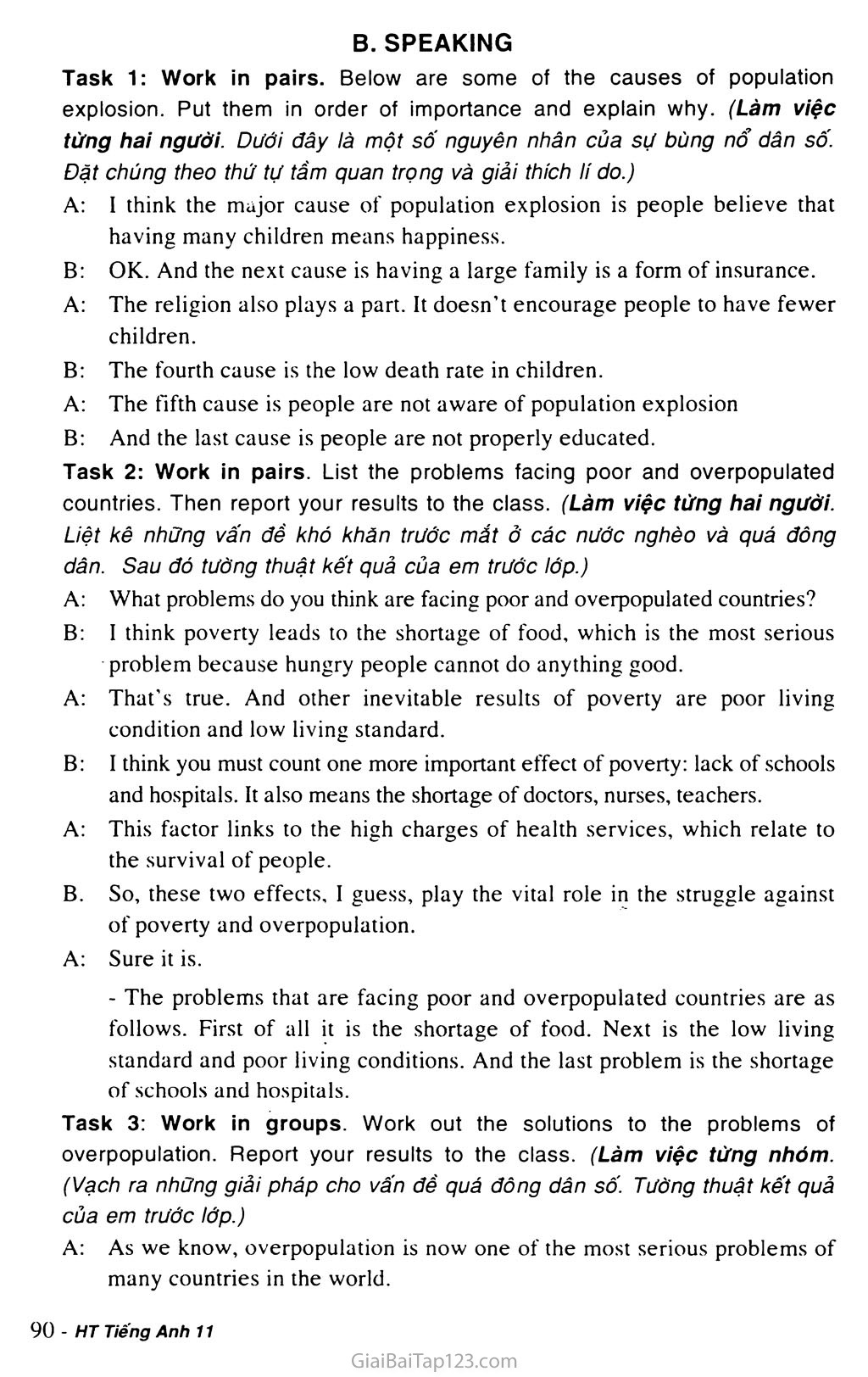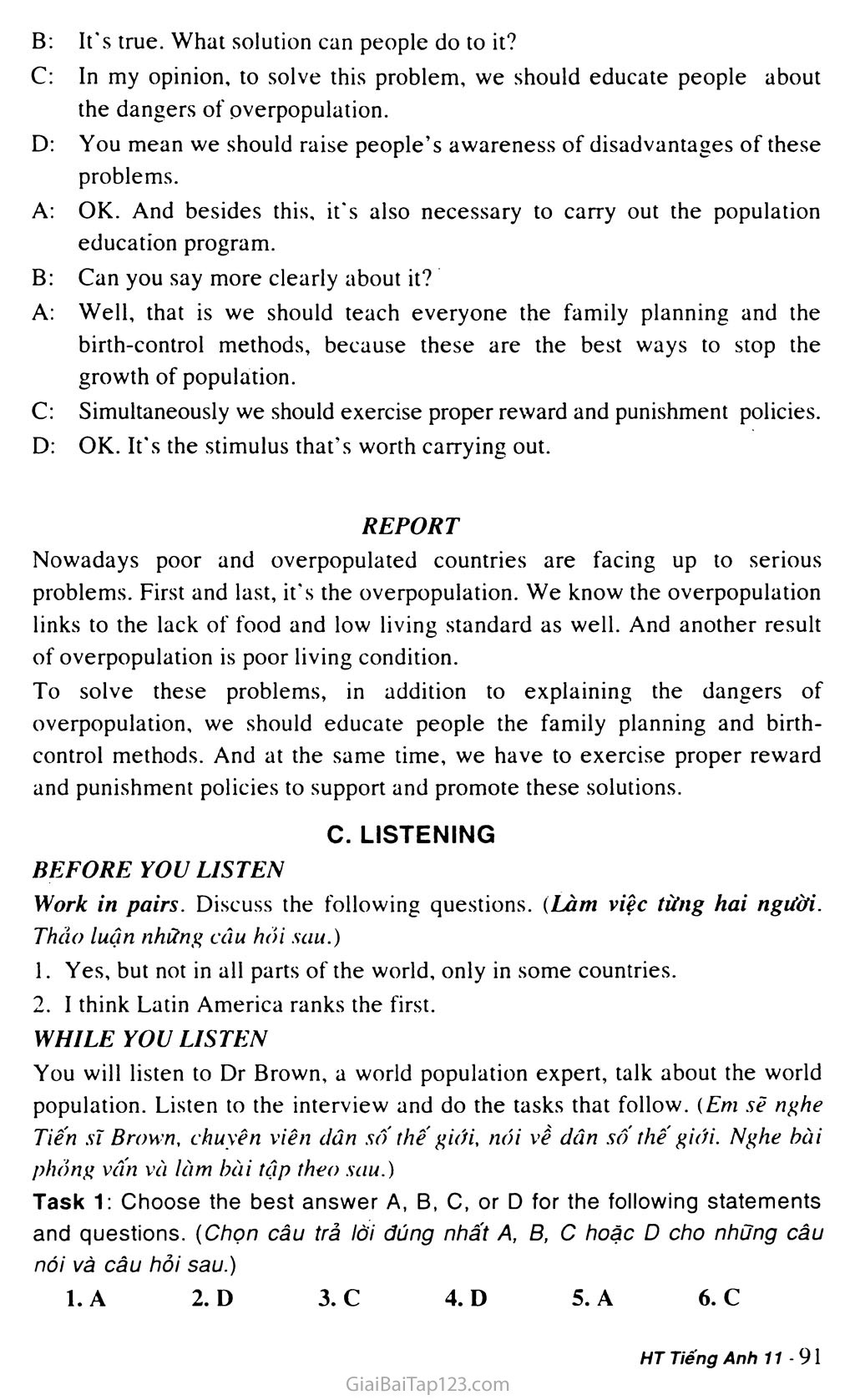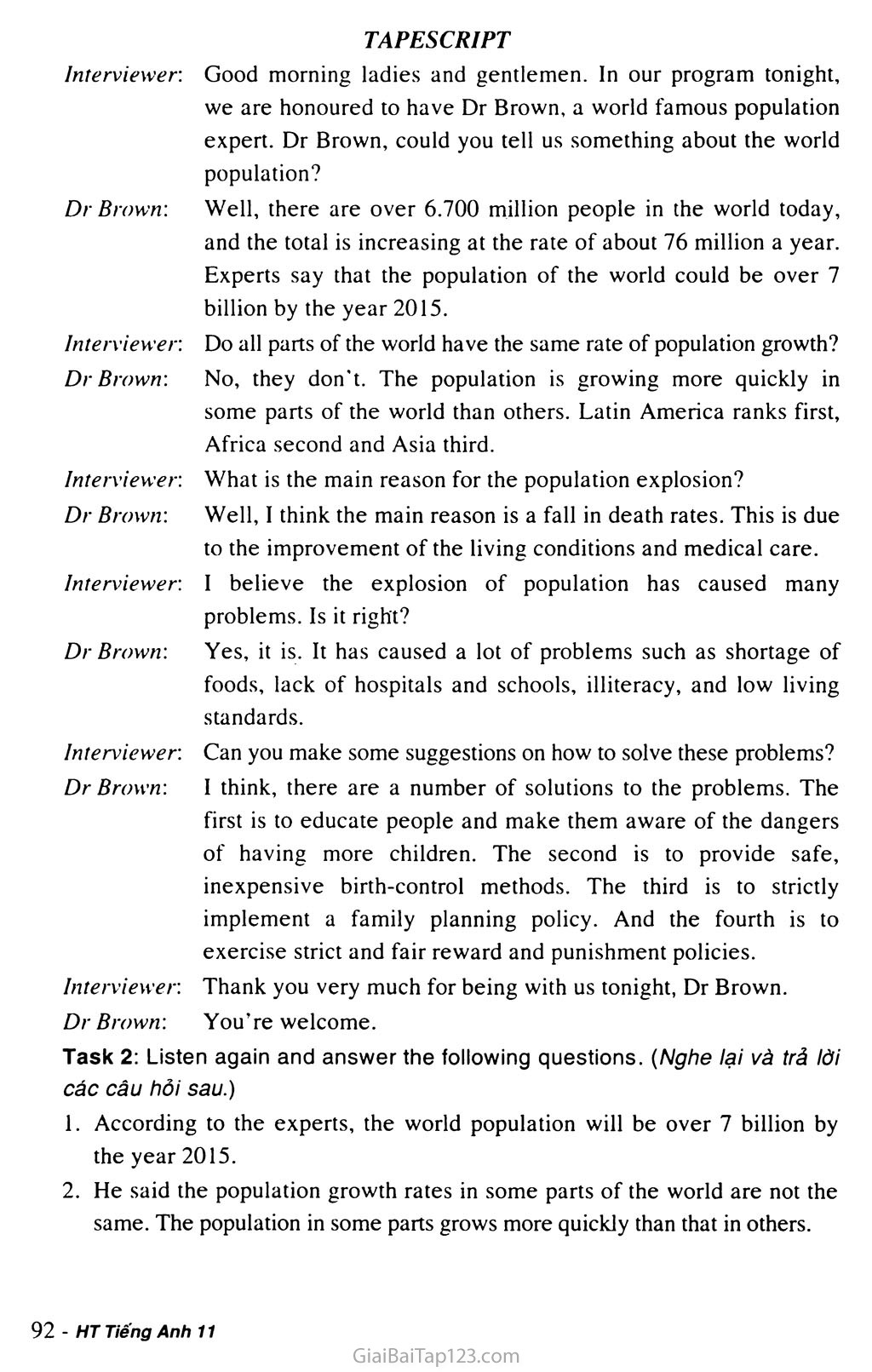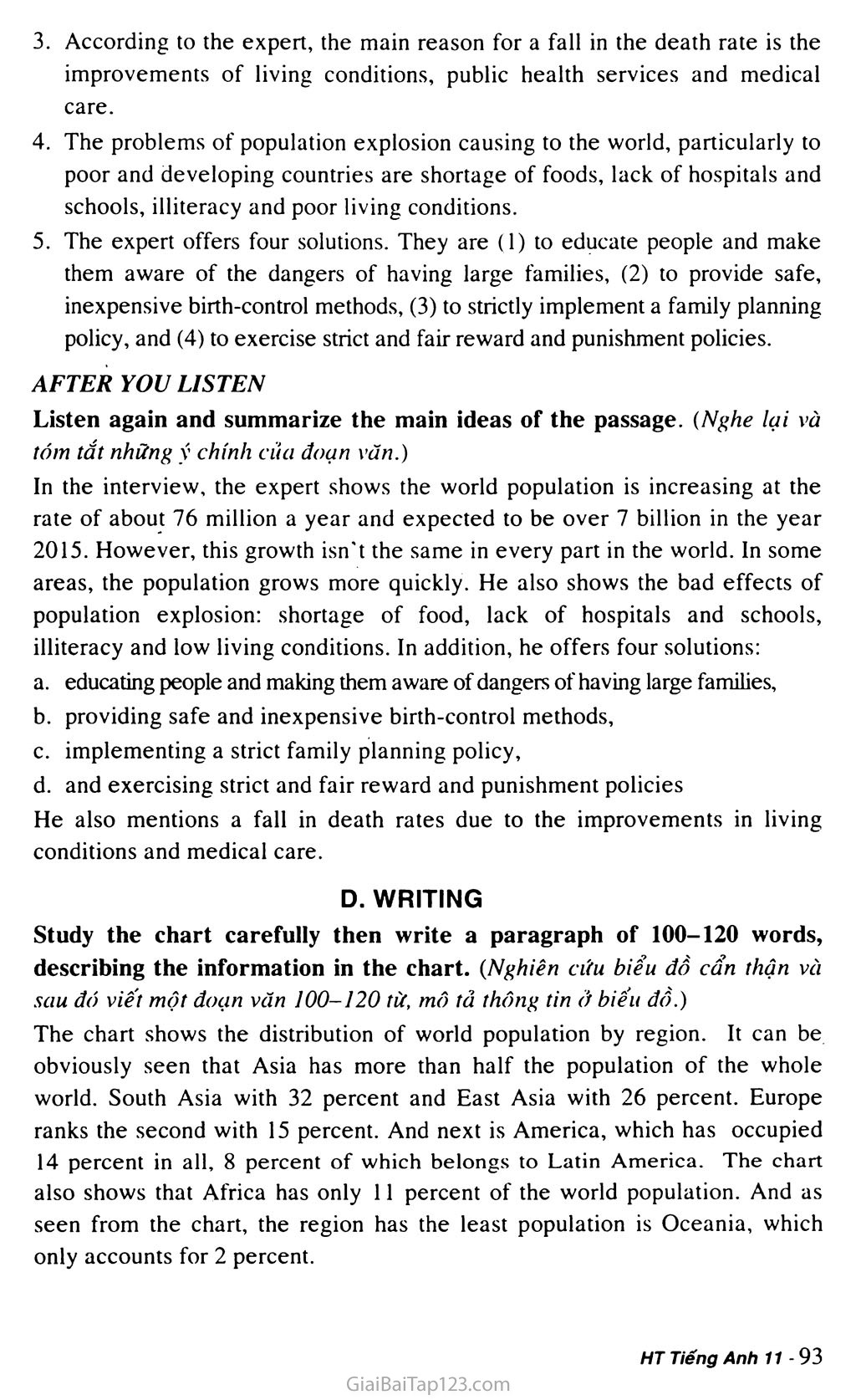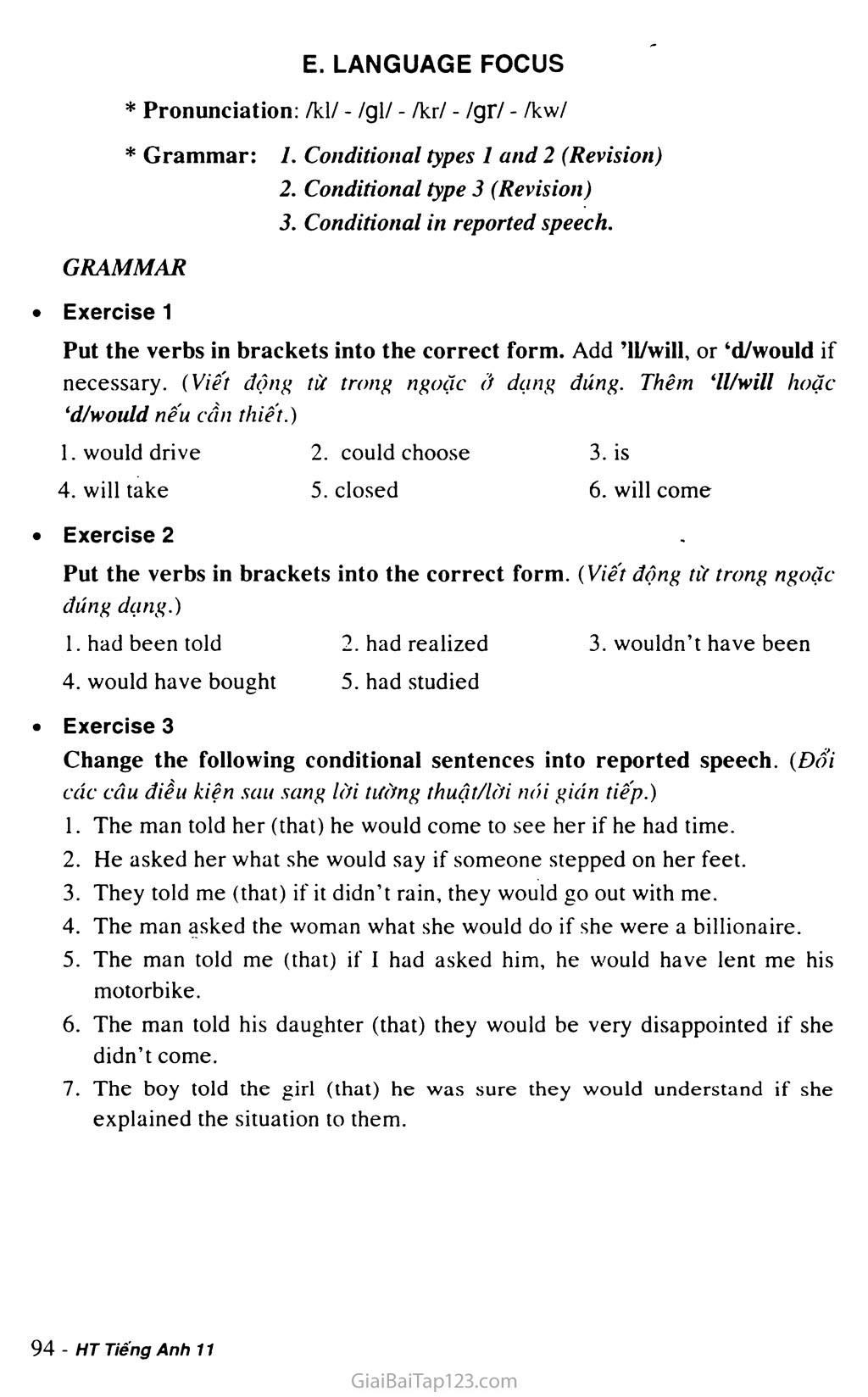Giải tiếng Anh lớp 11 Unit 7: WORLD POPULATION
WORLD POPULATION
(Dan so
VOCABULARY
figure
[‘figs]
(n):
con so
double
[‘dAbl]
(n) :
(V):
lượng gấp đôi, bản sao tăng gấp đôi
resources
[ri’so:siz]
(n) :
nguồn tài nguyên
support
[sa’po:t]
(V):
(n) :
nuôi, chịu đựng
sự ủng hộ, nguồn sinh sông
supportable
[sa’poitabl]
(adj)
: có thể chịu đựng
limit
[‘limit]
(n):
(V) :
giới hạn, sự hạn chế hạn chê
limitation
[ limi’teijn ]
(n) :
sự hạn chế, sự hạn định
limited
[‘limitid]
(adj)
: có hạn. hạn chê
raise animals
[reiz asnimlz]
nuôi thú vật
petroleum
[ pa’treuliam]
(n):
dầu mb
iron
[‘aien]
(n) :
sắt
metal
[‘metl]
(n) :
kim loại
metallize
fmetalaiz]
(V):
chê thành kim loại
metallic
[ ma'tselik]
(adj)
: thuộc kim loại
birth-control
[‘ba: 0 ksn’trsul]
(n) :
Sự hạn chê sinh sản
method
[‘meOed]
(n) :
phương pháp
methodical
[mi’0Ddikl ]
(adj)
: có phương pháp
methodology
[ meOa’dDladji]
(n) :
phương pháp luận
methodize
[‘meOadaiz]
(V):
hệ thống hóa
available
[a’veilabl]
(adj)
: cá sẵn
availability
[aveila'bilati]
(n):
tính ích lợi
journalism
[‘d33:nalizm]
(n):
ngành báo chí, nghề viết báo
injury
[‘indjari]
(n):
thương tật
injure
[‘indsa]
(V):
làm bị thương
explosion
[ ik’splaujn ]
(n) :
tiếng nổ
explode
[ik’splaud]
(V):
nổ
explosive
[ik’splausiv]
(adj)
(n) :
: có thể nổ
thuốc/chất nổ
be aware of
[bi: a'wearav]
(V):
realize : V thức
awareness
[a’weanis]
(n):
ý thức
religion
[n’lid3n]
(n):
tôn giáo
religious
[ri’ lid^as]
(adj)
: thuộc tôn giáo, sùng đạo
insurance/ensurance
[in’Joarans]
(n):
sự bảo hiểm
insure/ensure
[in’Jua]
(V):
báo hiếm
insurable
[in’Jusrabl ]
(adj)
: có thể bảo hiểm
insured
[in’Juad]
(adj)
: được bảo hiểm
overpopulated
[aova’pDpjuleitid] (adj)
: đông dân quá mức
overpopulation
[aova’pDpjuleiJn]
(n):
sự đông dân quá mức
living standard
[‘livip ‘stasndad]
(n):
mức sống
standard
|‘staendad]
(n) :
tiêu chuẩn
standardize
[‘stsendadaiz]
(V):
tiêu chuẩn hóa
standardization
[stasndadai’zeijn] (n):
sự tiêu chuẩn hóa
implement
[ ‘impliment]
(V):
take action: í/ỉực hiện
implementation
[implimen'teijh]
(n) :
sự thực hiện
implementary
[implim'entri]
(adj)
: thuộc sự thực hiện
carry out
[‘kaeri out]
(V):
realize, implement: thực hiện
punishment
[‘pAniJmant]
(n) :
hình phạt, sự phụt
punish
[‘pAmJl
(V):
phạt
shortage
rank
generation
generational
improvement
improve
expert
expert in/at expertise
strictly
distribution
distribute
distributive
region
regional
evenly
even
account for wake someone up billionaire
[‘Jo:tid3]
[raerjk ] [dsens’reijn] [d3en9’reijnl] [im’prmvmant] [im’prmv] [‘eksp3:t] [‘eksp3:t] [eksp3:’ti:z] [‘stnktli ] [distn’bjujn] [dis‘tribju:t] [dis [dis‘tribju:tiv] [‘ndjn]
[lnd3nl]
[li:vnli]
[*i:vn]
[s’kaunt1 [weik Ap] [b'llijsnee]
(n) : want, lack: sự thiếu, khan hiếm (n) : hạng, loại', (v): xếp hạng (n) : thế hệ
(adj) : thuộc thế hệ
(n) : sự cải thiện/cải tiến
(v) : cải tiến/cải thiện
(n) : chuyên viên
(adj) : chuyên mân, thành thạo
(n) : tài chuyên môn, sự tinh thông
(adv) : cách nghiêm túc/nghiêm khắc
(n) : sự phân phối
tribju:t] (v): give out: phân phối
(adj) : phân phối
(n) : vùng, miền
(adj) : thuộc vùng
(adv): cách đồng đều
(adj): divided equally: chia đồng đều
(v) : explain: giải thích
(v) : đánh thức ai
(n) : tỉ phú
IL GRAMMAR
REVISION: CONDITIONAL SENTENCES
(Ôn tập : Câu điểu kiện)
A. CONJUNCTIONS (Liên từ)
Ớ câu điều kiện, mệnh đề chỉ điều kiện thường bắt đầu bằng một trong những liên từ (conjunctions) sau: if, unless (trừ phi), as long as (miễn là), so long as (miễn là), provided (that) (miễn là, với điều kiện là), providing (như provided), . . .
B. KINDS OF CONDITIONS (Loại điều kiện)
1. Open/Likely condition (Điều kiện có thể xảy ra).
1. Form (Dạng)
“If” clause
Main clause
simple present
Present of modal + V
imperative
request
e.g.: If it rains, we won’t go on a picnic.
(Nếu trời mưa, chúng tôi không đi dã ngoại.)
If anyone calls, please take the message.
(Nếu có ai điện thoại, vui lòng nhận lời nhắn.)
Use (Cách dùng)
Câu điều kiện loại này được dùng diễn tả sự kiện có thể xảy ra ở tương lai.
2. Unreal/Suppositional condition (Điều kiện không thật/giả sử)
2.1. Present unreal condition (Điều kiện không thật ở hiện tại)
a. Form (Dạng)
“If” clause
Main clause
past subjunctive
be -» were
past of modal + V
* Past subjunctive (quá khứ giả định/bàng thái): có dạng giống
quá khứ đơn, trừ động từ BE, có một dạng duy nhát: WERE.
e.g.: If my brother were here, he would help me with this work.
(Nếu anh tôi ở đây, anh ấy giúp tôi công việc này.)
If you saw a fire, what would you do?
(Nếu bạn thấy đám cháy, bạn làm gì?)
b. Use (Cách dùng): Loại điều kiện này được dùng diễn tả điều kiện không thật hoặc trái với thực tế ở hiện tại.
Chú ý:
Cấu trúc-.
“IF I WERE YOU/IN YOUR POSITION/..., I WOULD (not) + V.
IF YOU WERE ME/IN MY POSITION, WHAT WOULD YOU
DO?”: được dùng diễn tả/xin lời khuyên (advice).
e.g: If I were you, I would take a course in Japanese.
(Nếu tôi là bạn, tôi theo học khóa tiếng Nhật.)
If you were in my situation, what would you do?
(Nếu bạn ở hoàn cảnh tôi, bạn làm gì?)
“COULD” được dùng ở mệnh đề điểu kiện (“IF” clause): diễn tả điểu kiện có thể xảy ra theo lí thuyết, nhưng không thực hiện được ở hiện tại.
e.g. If he could speak Japanese, he would get the job in the company.
(Nếu anh ấy nói được tiếng Nhật, anh ấy nhận được việc làm ở công ty đó.)
2.2. Past unreal condition (Điều kiện không thật trong quá khứ). a. Form (Dạng)
“If” clause
Main clause
past perfect
Subjunctive
had + p.p.
past of modal + have
+ p.p.
* past perfect subjunctive: thì t/uá khứ hoàn thành giả định/bàng thái: có dạng giống thì quá khứ hoàn thành đơn: HAD + past participle (P.P.)
e.g.: If he had studied hard last year, he would have passed
the exams.
(Năm rồi nếu anh ấy học chăm, anh ấy thi đậu.) b. Use (Cách dùng) : Điều kiện này diễn tả sự kiện trái với thực tế ở
quá khứ.
2.3. Future unreal condition (Điều kiện không thật ở tương lai).
Form (Dạng)
“If” clause
main clause
past subjunctive
WERE TO + V (base form)
past of modal + V
e.g.: If the next test weren’t to be difficult, many students would pass it.
(Nếu kì thi kê không khó. nhiều học sinh thi đậu.)
If my brother were to be here, I would take him to the art museum.
(Nếu anh tôi (sẽ) cá mặt ở đây. tôi đưa anh ấy thăm nhà bảo tàng nghệ thuật.)
Use (Cách dùng): Điều kiện này được dùng diễn tả sự kiện không thật/trái với thực tế ở tương lai.
3. Omission of IF in “IF” clauses. (BỎ “IF” ở mệnh đề điều kiện).
Nếu mệnh đề điều kiện có trợ động' từ, chúng ta có thể bỏ từ “IF” bằng cách dùng đảo ngữ.
e.g. If you had come to the party, you would have met your brother.
■* Had you come to the party, you’d have met your brother.
If I were you, I wouldn’t take the job offer.
(Nếu tôi là bạn, tôi không nhận lời đề nghị việc làm đó.)
-*■ Were I you, I wouldn't take that job offer.
c. CONDITIONAL SENTENCES in REPORTED SPEECH
(Câu điểu kiện trong Lời nói gián tíếp/Lời tường thuật)
Open/Likely condition. (Điều kiện có thể xảy ra).
e.g.: He said, “If I have much money, I’ll travel around the world.”
(Anh ấy nói, “Nếu tôi có nhiều tiền, tôi sẽ du lịch vòng quanh thê giới.)
-* He said (that) if he had much money, he would travel around the world. “If it rains, take the clothes in", her mother said to her.
(Mẹ cô ấy nói với cô, "Nếu trời mưa, đem quần áo vào. ”)
-* Her mother told her to take the clothes in if it rained.
Chú ỷ: Với câu điểu kiện có thể xảy ra, chúng ta áp dụng quy tắc chung
của lời nói gián tiếp/lời tường thuật.
Unreal/Suppositional conditions. (Điều kiện không thật/giã sử): chúng ta giữ nguyên - không đổi.
e.g.: He said, “If I had two wings. I'd fly everywhere.”
(Anh ấy nói, “Nếu tôi có hai cánh, tôi bay khắp nơi.)
-*■ He said (that) if I had two wings. he‘d fly everywhere.
Tom said to me,” If he had bought that house. I’d have made a big fortune." (Tom nói với tôi, "Nếu tôi mua cái nhà dó, tôi dã giàu to.)
-*■ Tom told me (that) if he had bought the house, he would have made a big fortune.
III. SOLUTIONS and TRANSLATIONS (LỜỈ GIẢI VÀ BÀI DỊCH)
A. READING
BEFORE YOU READ
Work ill pairs. Ask and answer the following questions. (Làm việc từng hai người. Hỏi và trả lời các câu hỏi sau.)
- These scenes can be found in poor or under-developed countries.
- The upper picture describes a poor large family in the remote village.
The lower picture may describe a poor slum in a small town or city.
I don’t think it usually is, but it depends on the leardership of the men - in
power concerned. For example, China is the most populated country in the world; however, before 1986, it still had been a poor country, where people had low income and living standard. Now, after more than 20 years of reform, China is now one of the most powerful countries. Isn’t it based on the leadership of the government?
Therefore it is said the main cause of development or prosperity isn’t based on the size of the population but on the leadership of the country. In sum, we cannot say the larger in population a country is, the stronger it is.
WHILE YOU READ
Read the passage and then do the tasks that follow. (Đọc đoạn văn và sau đó làm bài tập theo sau.)
Dân số thế giới đang ngày càng tăng nhanh. Nãm 10.000 trước Công nguyên có lẽ chỉ có 10 triệu người. Năm thứ nhát Công nguyên, có 300 triệu người. Phải mâ"t 1.750 năm để dân số thế giới đạt đến 625 triệu. Năm 1850, chỉ 100 năm sau, dân số’ đã đạt đến con sô" 1.300 triệu. Năm 1950, con sô" đó đã tăng gâ"p đôi, đến 2.510 triệu. Năm 1985, chỉ 35 năm sau, có 4.760 triệu người. Năm 2000, dân sô" thế giới khoảng 6, 6 tỉ người, và khoảng năm 2015, con sô" có thể hơn 7 tỉ.
Trái Đâ"t có đủ tài nguyên để nuôi nhiều người thế này không? Nhiều nhà khoa học khác nhau trả lời khác nhau cho câu hỏi này. Một sô" nhà khoa học nói rằng có đủ tài nguyên để nuôi 8 tỉ người. Những người khác nói rằng chúng ta phải hạn chê" sự phát triển dân sô" vì tài nguyên của chúng ta có giới hạn. Chỉ 10% đâ"t trồng của trái đất có thể được sử dụng cho nông nghiệp và 20% khác cho việc nuôi động vật. Nưổc chúng ta dùng có giới hạn. Cũng có hạn định cho sô lượng dầu mỏ, sắt, bạc, vàng và các kim loại khác.
Một nghiên cứu cho thây rằng một phụ nữ trung bình ở các nước kém phát triển có nhiều con hơn bà ta muôn. Trong sô những phụ nữ không nghĩ rằng họ có quá nhiều con, phân nửa trong sô" đó không muôn có thêm con nữa. Tuy nhiên, mặc dù hàng triệu phụ nữ muôn hạn chê" gia tăng sô" lượng người trong gia đình của họ, họ không biết một phương pháp an toàn nào để có ít
con hơn. Những phương pháp hạn chế sinh sản an toàn cho việc kế hoạch hóa gia đình không có sẩn cho họ. Đã đến lúc các chính phủ và tổ chức quốc tế làm điều gì đó giúp họ để dân số thế giới có thể bắt đầu giảm thay vì tiếp tục tăng.
Task 1: The words in the box all appear in the passage. Fill each blank with a suitable word. (Change the form of the word and use the dictionary when necessary. (Tất cả từ trong khung xuất hiện ở bài đọc. Điền mỗi chỗ trống với từ thích hợp. Đổi dạng của từ và sử dụng tự điển khi cần.)
Although 2. method 3. increae 4. resources
5. figures 6. limit 7. international 8. control
Task 2: Answer the questions on the passage. (Trả lời câu theo đoạn văn.)
The population of the world in 10.000 BC was 10 million; in 1750 it was 625 million; in 1850, 1.300 million; in 1950, 2.510 million; in 1985, 4.7601 million and in 2000, 6,6 billion.
By the year 2010, the population of the world is expected to be 7 billion.
Some scientists say it can, but others say it can’t.
No, they don’t.
They can’t limit the size of their family because they know no safe way to have fewer children.
AFTER YOU READ
Work in pairs. Discuss with a partner and find out five world largest countries in population. Say where they are and which is the richest and which is the poorest country. (Làm việc từng hai người. Thảo luận vời một bạn cùng học và tìm năm quốc gia lớn nhất thê' giới về dân số. Nói những quốc gia này ở đâu và nước nào giàu nhất và nước nào nghèo nhất.)
A. Do you know five countries which have the most population in the
world?
B: Let me think ... They are China, India, the United States, Indonesia and Brazil.
A; Very good. Can you tell me where they are?
B: OK. China, India and Indonesia are in Asia. The United States and Brazil are in America.
A: I think the United States is the richest country. Which country is the poorest, you know?
B; It’s Indonesia.
B. SPEAKING
Task 1: Work in pairs. Below are some of the causes of population explosion. Put them in order of importance and explain why. (Làm việc từng hai người. Dưới đây là một số nguyên nhân của sự bùng nổ dân số. Dặt chúng theo thứ tự tầm quan trọng và giải thích lí do.)
A: I think the major cause of population explosion is people believe that having many children means happiness.
B: OK. And the next cause is having a large family is a form of insurance.
A: The religion also plays a part. It doesn’t encourage people to have fewer
children.
B: The fourth cause is the low death rate in children.
A: The fifth cause is people are not aware of population explosion B: And the last cause is people are not properly educated.
Task 2: Work in pairs. List the problems facing poor and overpopulated countries. Then report your results to the class. (Làm việc từng hai người. Liệt kê những vấn đề khó khăn trước mát ở các nước nghèo và quá đông dân. Sau đó tường thuật kết quả của em trước lớp.)
A: What problems do you think are facing poor and overpopulated countries?
B: I think poverty leads to the shortage of food, which is the most serious
problem because hungry people cannot do anything good.
A: That’s true. And other inevitable results of poverty are poor living
condition and low living standard.
B: I think you must count one more important effect of poverty: lack of schools and hospitals. It also means the shortage of doctors, nurses, teachers.
A: This factor links to the high charges of health services, which relate to the survival of people.
B. So, these two effects, I guess, play the vital role in the struggle against of poverty and overpopulation.
A: Sure it is.
- The problems that are facing poor and overpopulated countries are as follows. First of all it is the shortage of food. Next is the low living standard and poor living conditions. And the last problem is the shortage of schools and hospitals.
Task 3: Work in groups. Work out the solutions to the problems of overpopulation. Report your results to the class. (Làm việc từng nhóm. (Vạch ra những giải pháp cho vấn đề quá dông dân số. Tường thuật kết quả của em trước lớp.)
A: As we know, overpopulation is now one of the most serious problems of many countries in the world.
B: It's true. What solution can people do to it?
C: In my opinion, to solve this problem, we should educate people about the dangers of overpopulation.
D: You mean we should raise people’s awareness of disadvantages of these problems.
A: OK. And besides this, it's also necessary to carry out the population education program.
B: Can you say more clearly about it?
A: Well, that is we should teach everyone the family planning and the birth-control methods, because these are the best ways to stop the growth of population.
C: Simultaneously we should exercise proper reward and punishment policies. D: OK. It's the stimulus that’s worth carrying out.
REPORT
Nowadays poor and overpopulated countries are facing up to serious problems. First and last, it's the overpopulation. We know the overpopulation links to the lack of food and low living standard as well. And another result of overpopulation is poor living condition.
To solve these problems, in addition to explaining the dangers of overpopulation, we should educate people the family planning and birth- control methods. And at the same time, we have to exercise proper reward and punishment policies to support and promote these solutions.
LISTENING
BEFORE YOU LISTEN
Work in pairs. Discuss the following questions. (Làm việc từng hai người. Thảo luận những câu hói sau.)
Yes, but not in all parts of the world, only in some countries.
I think Latin America ranks the first.
WHILE YOU LISTEN
You will listen to Dr Brown, a world population expert, talk about the world population. Listen to the interview and do the tasks that follow. (Em sẽ nghe Tiến sĩ Brown, chuyên viên dân số thế gidi, nói về dân sô thê giới. Nghe hài phong vấn vả làm hài tập theo sau.)
Task 1: Choose the best answer A, B, c, or D for the following statements and questions. {Chọn câu trả lời đúng nhất A, B, c hoặc D cho những câu nói và câu hỏi sau.)
l.A 2. D 3. c 4. D 5. A 6. c
TAPESCRIPT
Interviewer. Good morning ladies and gentlemen. In our program tonight, we are honoured to have Dr Brown, a world famous population expert. Dr Brown, could you tell US something about the world population?
Dr Brown'. Well, there are over 6.700 million people in the world today, and the total is increasing at the rate of about 76 million a year. Experts say that the population of the world could be over 7 billion by the year 2015.
Interviewer: Do all parts of the world have the same rate of population growth? Dr Brown: No, they don't. The population is growing more quickly in some parts of the world than others. Latin America ranks first,
Africa second and Asia third.
Interviewer: What is the main reason for the population explosion?
Dr Brown: Well, I think the main reason is a fall in death rates. This is due
to the improvement of the living conditions and medical care.
Interviewer: 1 believe the explosion of population has caused many problems. Is it right?
Dr Brown: Yes, it is. It has caused a lot of problems such as shortage of foods, lack of hospitals and schools, illiteracy, and low living standards.
Interviewer: Can you make some suggestions on how to solve these problems? Dr Brown: I think, there are a number of solutions to the problems. The first is to educate people and make them aware of the dangers of having more children. The second is to provide safe, inexpensive birth-control methods. The third is to strictly implement a family planning policy. And the fourth is to
exercise strict and fair reward and punishment policies.
Interviewer: Thank you very much for being with US tonight, Dr Brown.
Dr Brown: You’re welcome.
Task 2: Listen again and answer the following questions. (Nghe lại và trả lời các câu hỏi sau.)
According to the experts, the world population will be over 7 billion by the year 2015.
He said the population growth rates in some parts of the world are not the same. The population in some parts grows more quickly than that in others.
According to the expert, the main reason for a fall in the death rate is the improvements of living conditions, public health services and medical care.
The problems of population explosion causing to the world, particularly to poor and developing countries are shortage of foods, lack of hospitals and schools, illiteracy and poor living conditions.
The expert offers four solutions. They are (1) to educate people and make them aware of the dangers of having large families, (2) to provide safe, inexpensive birth-control methods, (3) to strictly implement a family planning policy, and (4) to exercise strict and fair reward and punishment policies.
AFTER YOU LISTEN
Listen again and summarize the main ideas of the passage. (Nghe lại và tóm tắt những ý chính cùa đoạn văn.)
In the interview, the expert shows the world population is increasing at the rate of about 76 million a year and expected to be over 7 billion in the year 2015. However, this growth isn't the same in every part in the world. In some areas, the population grows more quickly. He also shows the bad effects of population explosion: shortage of food, lack of hospitals and schools, illiteracy and low living conditions. In addition, he offers four solutions:
educating people and making them aware of dangers of having large families,
providing safe and inexpensive birth-control methods,
implementing a strict family planning policy,
and exercising strict and fair reward and punishment policies
He also mentions a fall in death rates due to the improvements in living conditions and medical care.
D. WRITING
Study the chart carefully then write a paragraph of 100-120 words, describing the information in the chart. (Nghiên cứu biểu đồ cẩn thận và sau đó viết một đoạn văn 100-120 từ, mô tả thông tin ở biêu đồ.)
The chart shows the distribution of world population by region. It can be obviously seen that Asia has more than half the population of the whole world. South Asia with 32 percent and East Asia with 26 percent. Europe ranks the second with 15 percent. And next is America, which has occupied 14 percent in all, 8 percent of which belongs to Latin America. The chart also shows that Africa has only 11 percent of the world population. And as seen from the chart, the region has the least population is Oceania, which only accounts for 2 percent.
E. LANGUAGE FOCUS
* Pronunciation: /kl/ - /gl/ - Zkr/ - /gr/ - /kw/ * Grammar: 1. Conditional types 1 and 2 (Revision)
Conditional type 3 (Revision)
Conditional in reported speech.
GRAMMAR
Exercise 1
Put the verbs in brackets into the correct form. Add ’11/will, or ‘d/would if necessary. (V/ếz động từ trong ngoặc ở dạng đúng. Thêm ‘ll/will hoặc ‘d/would nếu cần thiết.)
1. would drive 2. could choose 3. is
will take 5. closed 6. will come
Exercise 2
Put the verbs in brackets into the correct form. (Viết động từ trong ngoặc đúng dạng.)
1. had been told 2. had realized 3. wouldn’t have been
would have bought 5. had studied
Exercise 3
Change the following conditional sentences into reported speech. (Đổi các câu điều kiện sau sang lời tường thuật/lời nói gián tiếp.)
The man told her (that) he would come to see her if he had time.
He asked her what she would say if someone stepped on her feet.
They told me (that) if it didn’t rain, they would go out with me.
The man asked the woman what she would do if she were a billionaire.
The man told me (that) if I had asked him, he would have lent me his motorbike.
The man told his daughter (that) they would be very disappointed if she didn’t come.
The boy told the girl (that) he was sure they would understand if she explained the situation to them.

